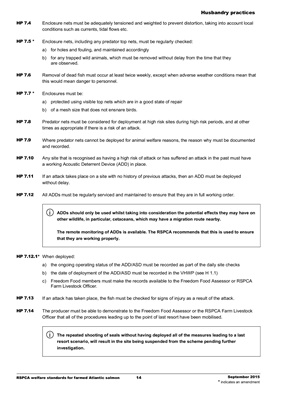
Husbandry practices
RSPCA welfare standards for farmed Atlantic salmon 14 September 2015
* indicates an amendment
HP 7.4 Enclosure nets must be adequately tensioned and weighted to prevent distortion, taking into account local
conditions such as currents, tidal flows etc.
HP 7.5 * Enclosure nets, including any predator top nets, must be regularly checked:
a) for holes and fouling, and maintained accordingly
b) for any trapped wild animals, which must be removed without delay from the time that they
are observed.
HP 7.6 Removal of dead fish must occur at least twice weekly, except when adverse weather conditions mean that
this would mean danger to personnel.
HP 7.7 * Enclosures must be:
a) protected using visible top nets which are in a good state of repair
b) of a mesh size that does not ensnare birds.
HP 7.8 Predator nets must be considered for deployment at high risk sites during high risk periods, and at other
times as appropriate if there is a risk of an attack.
HP 7.9 Where predator nets cannot be deployed for animal welfare reasons, the reason why must be documented
and recorded.
HP 7.10 Any site that is recognised as having a high risk of attack or has suffered an attack in the past must have
a working Acoustic Deterrent Device (ADD) in place.
HP 7.11 If an attack takes place on a site with no history of previous attacks, then an ADD must be deployed
without delay.
HP 7.12 All ADDs must be regularly serviced and maintained to ensure that they are in full working order.
ADDs should only be used whilst taking into consideration the potential effects they may have on
other wildlife, in particular, cetaceans, which may have a migration route nearby.
The remote monitoring of ADDs is available. The RSPCA recommends that this is used to ensure
that they are working properly.
HP 7.12.1* When deployed:
a) the ongoing operating status of the ADD/ASD must be recorded as part of the daily site checks
b) the date of deployment of the ADD/ASD must be recorded in the VHWP (see H 1.1)
c) Freedom Food members must make the records available to the Freedom Food Assessor or RSPCA
Farm Livestock Officer.
HP 7.13 If an attack has taken place, the fish must be checked for signs of injury as a result of the attack.
HP 7.14 The producer must be able to demonstrate to the Freedom Food Assessor or the RSPCA Farm Livestock
Officer that all of the procedures leading up to the point of last resort have been mobilised.
The repeated shooting of seals without having deployed all of the measures leading to a last
resort scenario, will result in the site being suspended from the scheme pending further
investigation.
i
i